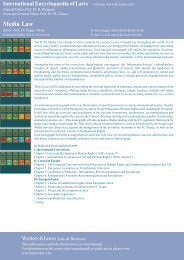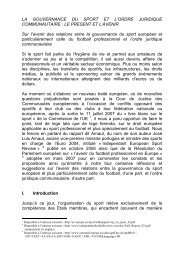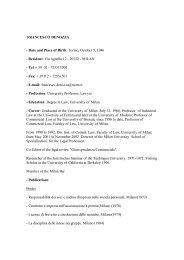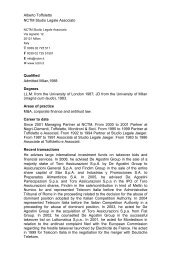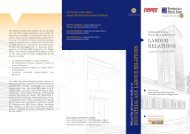USA - International Encyclopaedia of Laws
USA - International Encyclopaedia of Laws
USA - International Encyclopaedia of Laws
You also want an ePaper? Increase the reach of your titles
YUMPU automatically turns print PDFs into web optimized ePapers that Google loves.
Constitutional Formation and Design, Part I, Ch. 1 77–79voters. In states without such provisions in their constitutions, it is nowunderstood that the state legislature may provide for the calling <strong>of</strong> a convention,limitations upon the subjects that may be considered at the convention, and thesubmission <strong>of</strong> proposals to the voters.77. For new states being admitted to the Union, the Congress <strong>of</strong> the UnitedStates exercises the power to decide on their admission. As a part <strong>of</strong> thisprocess, the new state must submit its proposed constitution to the Congress andthe President for approval. In some <strong>of</strong> the instances <strong>of</strong> admission <strong>of</strong> new states,Congress would pass an ‘enabling act’ prior to the submission <strong>of</strong> the new state’sapplication for admission to the Union. These enabling acts <strong>of</strong>ten containedrequirements for the calling and holding <strong>of</strong> constitutional conventions, and also<strong>of</strong>ten contained specific requirements that certain provisions be included in theproposed constitution <strong>of</strong> the state. In addition, there are several examples <strong>of</strong> stateconstitutions being rejected by Congress or the President until specified changeswere made. Once the state was admitted to the Union, however, it was free tochange its constitution however it saw fit.§9. PROCESSES FOR AMENDMENT (ALTERATION) AND REVISION (REPLACE-MENT)78. The American states have regularly revised and amended theirconstitutions. Only nineteen states still retain their original constitutions, anda majority <strong>of</strong> states have established three or more. Louisiana’s current constitutionis the state’s eleventh, and Georgia’s its tenth. The level <strong>of</strong> constitutionalamendment likewise underscores the states’ willingness to initiate formalconstitutional change. As <strong>of</strong> 1998, over 9500 amendments had been proposedto the states’ current constitutions and over 5900 adopted – an average <strong>of</strong> almost120 amendments per state. The Alabama Constitution <strong>of</strong> 1901 has been amendedover 580 times, and the California Constitution <strong>of</strong> 1879 almost 500 times. Eventhese figures substantially underestimate the states’ propensity for constitutionaltinkering, because they omit amendments and proposed amendments to thestates’ earlier constitutions.79. Constitutional revision (replacement) has occurred through constitutionalconventions. Forty-one state constitutions expressly authorize the legislature toconvene constitutional conventions – indeed, fourteen require that the legislatureperiodically poll the populace on whether to call a convention – and statelegislatures have assumed the power to call conventions even in the absence <strong>of</strong>express constitutional authorization. The state legislature places on the ballotthe question <strong>of</strong> whether a constitutional convention should be called. In someinstances the ballot question may indicate that the convention is for limitedpurposes or that it will not consider certain issues. In 1947 in New Jersey, forexample, the legislature was willing to agree to a convention only if thedelegates were prohibited from changing the mode <strong>of</strong> apportionment for the statesenate. If the electorate approves calling a convention, delegates are elected byConstitutional Law – Suppl. 34 (October 1999) <strong>USA</strong> (Sub-national) – 35




